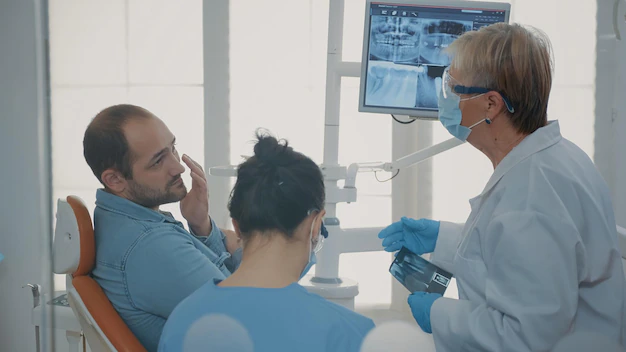Why Effective Communication Matters in Dentistry
In the intricate world of dentistry, where patient comfort and trust are paramount, effective communication plays a pivotal role. It’s the bridge connecting healthcare providers with those they serve, facilitating a better understanding and making daunting procedures less intimidating. Without it, misunderstandings can flourish, leaving patients with anxious confidence. Incorporating effective dental marketing into practice can seamlessly integrate communication strategies aimed at education and reassurance rather than overwhelming patients with technical details. Marketing has a role in enhancing the patient experience within healthcare as they are closely interconnected. The more positive a patient’s experience, the more tremendous success a healthcare provider will achieve, and marketers play a crucial part in creating effective communication.
The essence of communication is more comprehensive than in face-to-face interactions. It extends to the nuances of non-verbal cues, tone modulation, and even the written instruction given to patients. Each aspect works in tandem to assure patients of the quality care they receive. Moreover, as the industry becomes increasingly competitive, the ability to communicate effectively will differentiate successful practices from those left behind.
Critical Techniques for Improving Communication
Mastering the art of dental communication begins with active listening. It’s about being present in the conversation and catching verbal and nonverbal hints that might indicate a patient’s anxiety or lack of understanding. Responding to these cues by asking clarifying questions can make a difference. Additionally, breaking down complex dental terminologies into everyday language helps demystify procedures. When a patient comprehends the process they’re about to undergo, it significantly reduces anxiety and builds trust.
Furthermore, engaging patients with open-ended questions stimulates a two-way conversation. This tactic uncovers lingering doubts and reinforces patients’ autonomy in healthcare decisions. Encouragement to voice concerns or queries ensures the communication channel remains open and transparent. Ultimately, these approaches create a supportive environment where patients feel involved and empowered.
The Role of Empathy and Understanding
Empathy is not only a desirable trait in dentistry; it’s essential. When patients feel genuinely understood, it builds a strong rapport and calms nerves. Demonstrating empathy involves acknowledging a patient’s fears and responding with patience and care. Practices that cultivate empathy witness higher patient satisfaction rates, as trust and emotional comfort are prioritized alongside dental care. A relational app ensures personalized care, where patients are treated as individuals rather than just oral health care. The small gestures – a calm voice, a reassuring smile, and a willingness to listen – go a long way in shaping the patient experience. These elements create an atmosphere conducive to open dialogue, where patients feel their emotions are as important as the clinical advice they’re given.
Real-Life Insights: Communication in Action
Take, for instance, the case of a progressive dental practice in the U.S. that recognized the transformative power of communication and achieved remarkable outcomes. Implementing a comprehensive program focused on enhancing staff communication comes. Over six months, patient referrals increased by 30%, a testament to the practice’s commitment to effective patient interaction. This real-world example underscores how strategic communication can enhance patient satisfaction and significantly impact a practice’s bottom line. Patients who feel seen and heard are more likely to trust their providers and eventually become advocates for the practice. Their recommendations elevate the practice’s reputation, helping it thrive in a competitive market. This cycle of trust and advocacy is the ultimate goal of any healthcare provider looking to make a meaningful impact.
Leveraging Digital Tools for Better Engagement
The digital age has brought unprecedented advancements to dental practice mechanisms, particularly in patient communication. Automated systems for appointment reminders, digital check-ins, and online portals for medical histories have enhanced efficiency and patient engagement. These tools facilitate continuous interactions beyond the confines of the dental office, making healthcare more accessible and convenient. By embracing technology, practices can cater to the modern patient’s need for information and interaction at their convenience. Digital platforms, when optimized, support a seamless patient journey from inquiry to aftercare. Moreover, they allow dental professionals to focus more on in-person patient care, knowing that digital components handle routine communications effectively.
Common Challenges and Solutions
Overcoming Jargon and Miscommunication
In any medical field, jargon can be a significant barrier to effective communication. Technical terms that need to be adequately explained can cause unease. The solution lies in translating these terms into plain language and ensuring clarity and transparency in every patient interaction. Practitioners should consider utilizing visual aids to enhance understanding further.
Addressing Anxiety and Fear
Anxiety is a known issue among dental patients, often stemming from a fear of the unknown. Addressing this begins with acknowledging and validating these emotions. Candid discussions about procedures, pain management options, and post-procedure care can relieve patients’ stress. When patients understand what to expect, their anxiety diminishes significantly, leading to a smoother care process.
Ensuring Consistent Messaging
Maintaining consistency in communication is vital in a dental practice, where multiple staff members might interact with a patient throughout their visit. Establishing standardized communication guidelines ensures that each team member conveys the same information and embodies the practice’s ethos. This uniformity boosts patient confidence and curtails the risk of miscommunication.
The Future of Dental Communication
The future of dental communication lies at the intersection of empathy and technology. By blending traditional, empathetic communication techniques with cutting-edge tools, dental practices can enhance patient care while staying ahead in a competitive market. This hybrid approach strengthens patient trust and aligns with the broader healthcare industry’s shift towards personalized, patient-centered care. In conclusion, effective communication is vital to any successful dental practice, contributing significantly to patient satisfaction, loyalty, and overall practice growth. As the industry continues to evolve, those who prioritize these strategies today are setting themselves up for success in the years to come.

